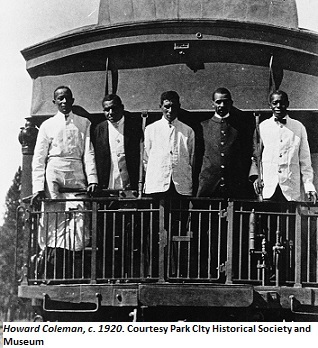Dublin Core
Title
Description
Meet Howard Coleman, who came West with the railroad and built a better life – one job at a time.
Like many of us, Howard Coleman used his work as a stepping stone to a better life. As a black man and the son of a Kentucky share-cropper, his options at home were limited. But he found and seized opportunities, first as a soldier in World War I, and then as a Pullman porter working on the railroad.
Pullman porters were men hired to serve passengers on overnight trains, journeys that were made more comfortable when industrialist George Pullman introduced sleeper cars in the late 1800s. Pullman capitalized on middle-class America’s desire to travel in style, and staffed his sleeper cars with porters to work as butlers, waiters, and servants. He hired these positions from the huge influx of freed slaves looking for paid work in the decades following the Civil War. Pullman had the racially-motivated idea that as former slaves, black men embodied servility and would accept lower wages than white men. In Pullman’s mind, they were the perfect workforce to fill the role of the ever-present manservant that luxury travelers demanded.
And yet, as wage work, portering offered black men a way up and out of the Reconstruction South with its Jim Crow laws and sharecropping. The porter’s union fought for better working conditions, and the steady paychecks gave these men a chance to save and create opportunities for their families. Because they traveled far and wide on the trains, porters brought back to their hometowns news of job opportunities and social connections in places like Chicago, Oakland, or right here in Utah.
So, Howard Coleman – along with many other porters in the 1920s – used his job to migrate from the South out West. Once in Utah, he found work in Park City, first as a hotel janitor, and later as caretaker of the post office, where he masterminded the garden and grounds for more than thirty-seven years. Coleman was a beloved fixture in Park City, where he was able to build a better life than the one he left behind.
Creator
Mahala Ruddell for the Park City Museum © 2017
Source
Image: Howard Coleman (middle, circa 1920) came west as a Pullman porter on the railroad and eventually settled in Park City, where he served as caretaker at the post office for over thirty-seven years. Image courtesy Park City Historical Society and Museum, Roslyn Stewart Collection.
____________
See“Howard Coleman: ‘A Good Kind Person,’” Park Record, February 21, 1980; “Howard Coleman, 95, Dies After Lifetime of Service,” Park Record, September 24, 1981; Lawrence Tye, “Choosing Servility to Staff America’s Trains,” The Alicia Patterson Foundation, May 5, 2011, http://aliciapatterson.org/stories/choosing-servility-staff-americas-trains; Morning Edition, “Pullman Porters Helped Build Black Middle Class,” NPR, May 8, 2005, http://www.npr.org/templates/story/story.php?storyId=103880184; “Lives on the Railroad: Pullman Porters,” America on the Move, National Museum of American History, http://amhistory.si.edu/onthemove/exhibition/exhibition_9_6.html.

